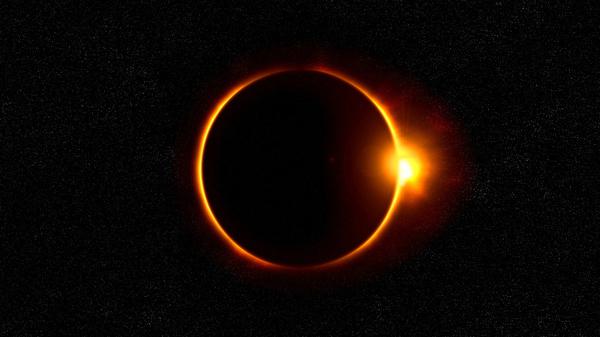2024’s spectacular solar eclipse: A celestial phenomenon

The cosmos is set to present a majestic spectacle on Monday, April 8, 2024, as the first total solar eclipse since 2024 engulfs parts of North America in darkness.
This rare event occurs when the Moon, drawing nearer to Earth, positions itself directly between our planet and the Sun, casting a shadow over the Earth and momentarily blocking the sunlight.
This astronomical event follows the first lunar eclipse of the year, witnessed on March 25, 2024, adding to the year’s celestial wonders. Scientists have highlighted that this solar eclipse is expected to bring about not just a visual marvel but also trigger several unusual earthly and atmospheric phenomena.
A study recently uncovered that solar eclipses impact cloud formation, with observations of shallow cumulus clouds disappearing during such events, showcasing the broad environmental influence of eclipses.
The path of totality, where the eclipse’s full effect can be observed, will stretch across Mexico, the United States, and Canada, covering a width of 185 kilometres.
It’s estimated that 18 U.S. states will experience the dark veil of totality, making it a highly anticipated event for skywatchers in these regions.
Unfortunately, enthusiasts in India will have to wait until May 21, 2031, for the next solar eclipse visible from their location, which will be an annular ring of fire eclipse.
The duration of the 2024 eclipse is set to be around two and a half hours, with the total eclipse phase lasting approximately four minutes.
According to NASA, the peak of the eclipse could extend up to 4 minutes and 27 seconds for those situated along the path of total darkness.
This duration surpasses that of the Great American Eclipse of August 21, 2017, offering a longer window for observers to revel in the cosmic spectacle.
Despite the total solar eclipse not being visible in India, the event is a global marvel, drawing attention from around the world.
The eclipse’s path across North America promises a unique and unforgettable sight, marking a significant moment in 2024’s astronomical calendar.
Image from Pxhere (Free for commercial use / CC0 Public Domain)
You may also like
Image Reference: https://pxhere.com/en/photo/597908
Recent Posts
- CERT-In flags ‘ghostpairing’ threat targeting WhatsApp usersBy abusing this feature, cyber criminals can secretly attach their own device to a victim’s account.
- VB–G RAM G Act gets Presidential nodThe law introduces flexibility to support agricultural productivity.
- Delhi to Meerut in 40 Minutes: Riding the Namo Bharat RRTSIndia’s first Regional Rapid Transit System is redefining fast and comfortable travel across the NCR. Watch the video to know more about the Delhi-Meerut Namo Bharat journey, showcasing speed, comfort, stations, and the seamless travel experience.
- CERT-In flags ‘ghostpairing’ threat targeting WhatsApp users
What’s new at WeRIndia.com
News from 700+ sources
-
SMC of Munaivendri Govt. school demand immediate renovation of school buildings
-
Bangladesh editors warn of fight for survival as mob violence targets media
-
Jana Sena a regional party with national outlook: Pawan Kalyan
-
Seven accused in Hangal gang rape externed from Haveri district
-
Farmers seek solar fencing to protect crops from wild animals
-
ACB nabs govt. official while accepting bribe
-
WeRIndia – A News Aggregator
Visit werindia.com for all types of National | Business | World | Politics | Entertainment | Health related news and much more..








Leave a Reply